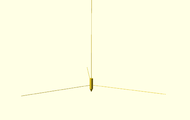Hangprinter
Release status: concept
| Description | A RepRap using walls and ceiling as its frame
|
| License | |
| Author | |
| Contributors | |
| Based-on | |
| Categories | |
| CAD Models | OpenSCAD
|
| External Link |
Contents
Updates
This page has not been updated since the very early days of Hangprinter development. Until someone gives this wiki-page an overhaul, use refer to dev blog (https://vitana.se/opr3d/tbear/) and Gitlab repo (https://gitlab.com/tobben/hangprinter). See also the old Github repo (https://github.com/tobbelobb/hangprinter) instead. -tobben
Ideas the design is meant to implement
- A print-head that hangs down in a string from the ceiling.
- Put all the hardware (except AC/DC-converter) in one single unit.
It should be possible to install in a house by simply by attaching strings to anchor points in walls and ceiling, power wire to circuit board and filament to extruder.
Assumed advantages from using house as frame
- Low part count
- Easy to print, assemble, install and distribute
- Huge build volume (especially height).
- When printer is idle, one could retract all the strings. Hanging it in the z-achor point (the ceiling) with no dangeling strings might be elegant storage solution. Could make it popular in big cities, where indoor area is scarce.
Difficulties
- Special geometry-compensating firmware
- Keeping strings tight
- Keeping rotation at zero
- Finding a reasonable home position
- Convincing people to put anchor points (screws) in walls...
Geometry compencating firmware
Converting from Cartesian coordinates to the four wire lengths we need is just a matter of using Pythagoras' Theorem. The maths needed to regulate the velocities properly has not been worked out.
Keeping strings tight
We need to know if springs are wanted/needed. Some work on this has been done, check out SkyDelta [1], [2] and the forum thread for details.
Keeping rotation at Zero
Things that will produce forces
- Dragging filament around
- Dragging power cable around
- Accelerating motors
Comments
Rotation around z-axis might be considered less harmfull since one could place the hotend in the rotational midpoint. All motors probably need to be downshifted heavily, and accelerations kept minimal. It might have to be a very slow printer. Will it help to keep all motor shafts in paralell with the z-direction in order to avoid induced xy-torque? Will it need a very thought out extruder?
Finding Home Position
Procedure Based on Known Positions
This has being worked on in the RigTig community. Basic idea is that instead of measuring the anchor points you drive the print head manually to a set of known point and determine the geometry of the printer from the differences in cable lengths needed to get from one point to another. We got a first grip on the mathematics involved:
https://hackaday.io/project/13420-rigtigs-big-3d-printer/discussion-79916
-- Florian Festi
Video
<videoflash type="vimeo" align="center">114817782</videoflash>
Motors are working. (Tobben, 17 dec 2014)
Forum thread: [3]
